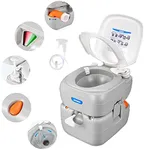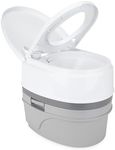Buying Guide for the Best Portable Toilets
Choosing the right portable toilet can make a big difference in comfort and convenience, whether you're camping, traveling, or preparing for emergencies. It's important to think about where and how you'll use the toilet, how many people will use it, and how often you'll need to empty or clean it. By understanding the key features, you can find a portable toilet that fits your needs and makes your experience much more pleasant.CapacityCapacity refers to how much waste the portable toilet can hold before it needs to be emptied. This is usually measured in liters or gallons. A smaller capacity (around 2-5 gallons) is lighter and easier to carry, making it suitable for solo travelers or short trips. Medium capacities (5-10 gallons) are good for small groups or families on weekend outings. Larger capacities (over 10 gallons) are best for bigger groups or longer stays, but they can be heavier and harder to move. Think about how many people will use the toilet and how often you want to empty it to choose the right size for your needs.
Flushing MechanismThe flushing mechanism is how the toilet rinses waste away after use. Some portable toilets have a manual pump or bellows, while others use a battery-powered flush. Manual flushes are simple and reliable, but may require more effort. Battery-powered flushes are more convenient and feel closer to a home toilet, but they need batteries and can be more expensive. If you want something easy and low-maintenance, a manual flush is a good choice. If comfort and convenience are your top priorities, consider a battery-powered option.
Waste Disposal MethodThis refers to how you empty and clean the portable toilet. Some models have a detachable waste tank with a spout for easy pouring, while others use disposable bags that you can seal and throw away. Detachable tanks are reusable and more eco-friendly, but require cleaning. Bag systems are very convenient and hygienic, especially for quick trips or when you can't access a dump station, but you'll need to buy replacement bags. Choose a method that matches your comfort level with cleaning and the facilities available where you'll be using the toilet.
Size and PortabilitySize and portability describe how easy it is to move and store the toilet. Compact models are lightweight and fit easily in a car or tent, making them ideal for backpacking or small spaces. Larger models offer more comfort and capacity but can be bulky and heavy. If you need to carry the toilet over long distances or have limited space, go for a smaller, lighter model. If you'll mostly use it in one place, a larger toilet may be more comfortable.
Seat Height and ComfortSeat height and comfort affect how easy and pleasant the toilet is to use. Lower seats are more compact but can be uncomfortable, especially for older adults or people with mobility issues. Higher seats feel more like a regular toilet and are easier to sit on and stand up from. Some models also have padded seats or armrests for extra comfort. Consider who will be using the toilet and their comfort needs when choosing the right seat height and features.
Odor ControlOdor control is about how well the toilet keeps smells contained. Some toilets have tight-sealing lids, built-in chemicals, or ventilation systems to reduce odors. Good odor control is important if you'll be using the toilet in a small space or for several days. If you're sensitive to smells or plan to use the toilet indoors or in a tent, look for models with strong odor control features.
Ease of CleaningEase of cleaning refers to how simple it is to keep the toilet sanitary. Smooth surfaces, detachable parts, and easy-to-access tanks make cleaning much easier. Some models are designed to be rinsed out quickly, while others may require more effort. If you want to spend less time on maintenance, look for a toilet with features that make cleaning straightforward.














